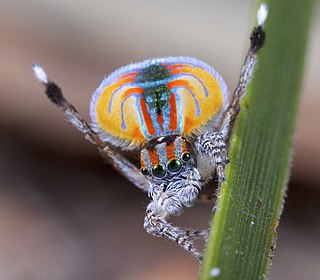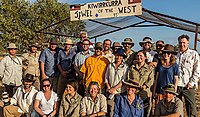
Abracadabrella is a genus of spiders in the family Salticidae whose species appear to mimic flies.

Afraflacilla is a genus of the spider family Salticidae. Most species are distributed in Eastern to Northern Africa and Australia, with two species found in Europe. This genus was for a time included in the genus Pseudicius, and the boundaries between both genera are disputed. In 2016 Jerzy Prószyński erected the genus Psenuc for some borderline species. The name Afraflacilla is combined from Africa, where most earlier described species were found, and FlacillaSimon, 1901, an obsolete salticid genus now called FlacillulaStrand, 1932. This genus name is in turn derived from Aelia Flaccilla, wife of Roman Emperor Theodosius I. Afraflacilla, Pseudicius, Festucula and Marchena are close relatives and form a monophyletic group.

Maratus is a spider genus of the family Salticidae. These spiders are commonly referred to as peacock spiders due to the males' colorful and usually iridescent patterns on the upper surface of the abdomen often enhanced with lateral flaps or bristles, which they display during courtship. Females lack these bright colors, being cryptic in appearance. In at least one species, Maratus vespertilio, the expansion of the flaps also occurs during ritualised contests between males. The male display and courtship dance are complex, involving visual and vibratory signals.

Australia has a number of highly venomous spiders, including the Sydney funnel-web spider, its relatives in the family Hexathelidae, and the redback spider, whose bites can be extremely painful and have historically been linked with deaths in medical records. Most Australian spiders do not have venom that is considered to be dangerously toxic. No deaths caused by spider bites in Australia have been substantiated by a coronial inquest since 1979. There are sensationalised news reports regarding Australian spiders that fail to cite evidence. A Field Guide to Spiders of Australia published by CSIRO Publishing in 2017 featuring around 836 species illustrated with photographs of live animals, around 381 genera and 78 families, introduced significant updates to taxonomy from Ramirez, Wheeler and Dmitrov.

Maratus speciosus, sometimes called the coastal peacock spider, is an Australian species of jumping spider. They are only known to inhabit the vegetation of the coastal sand dunes of southwestern Western Australia. Like other Maratus spiders, the males of the species engage in a courtship display during which they raise their third pair of legs and their abdomen, presenting their colourful opisthosomal plate to potential female partners. Accompanying their elaborate dance moves, males beat their front and back body halves together, sending vibrations that travel through the ground which the females pick up, stimulating them into receiving higher chances of a successful mate. Unlike other Maratus, however, the males of this species have a set of bright orange hairs (setae) along both edges of the opisthosoma which only become visible during this display. Maratus speciosus derives from the arachnid class with both sexes measuring about 5 mm in body length, equivalent to a pencil eraser. They are known as the smallest species of spiders. This organism is known as diurnal cursorial hunters, meaning they feed on insects. Like any other jumping spider, they rely on their keen vision and jumping actions to help them travel and spot prey at far distances.
Maratus albus is a species of the peacock spider genus, characterised by its distinctive courtship display.
Maratus australis is a species of the peacock spider genus, characterised by its distinctive courtship display.
Maratus bubo is a species of the peacock spider genus, characterised by its distinctive courtship display.
Maratus lobatus is a species of the peacock spider genus, characterised by its distinctive courtship display. They are found on the south coast of Western Australia and in South Australia.
Maratus tessellatus is a species of the peacock spider genus, characterised by its distinctive courtship display.
Maratus vespa is a species of the peacock spider genus, Maratus, characterised by its distinctive courtship display. The male spiders are characterized by a bright abdomen, lateral flaps, and an elongated third pair of legs. When attempting to attract a mate, the male spider will raise its colourful abdomen and elongated third pair of legs and wave them, along with extending its lateral flaps. This complex display of courtship is analogous to that of a peacock, hence the common name of this spider species.
Maratus vultus is a species of the peacock spider genus, characterised by its distinctive courtship display.
Maratus proszynskii is a species of the genus Maratus, first found in Tasmania.

Bush Blitz is a species discovery program conducting scientific surveys in Australian terrestrial and marine environments to document known and new fungi, plants and animals. The program is a partnership between the Australian Government, BHP Sustainable Communities and Earthwatch Australia. Bush Blitz is managed through Parks Australia and the Australian Biological Resources Study. The program began in 2010, the International Year of Biodiversity, involving specialist taxonomists, indigenous communities, rangers and landowners, teachers, students and BHP employees. Bush Blitz funds taxonomy and further research based on material collected during Bush Blitz surveys, specifically targeted to assist in the publication of new species and the resolution of problematic groups collected from surveys.
Barbara Baehr is a German research scientist, entomologist, arachnologist, and spider taxonomist. She has described over 400 new spider species, mostly from Australia. She is originally from Pforzheim, Germany.
Maratus unicup is a species of jumping spider of the genus Maratus.

Cosmophasis baehrae is a species of jumping spider found in Australia and the Moluccas, and first described in 2012 by Marek Zabka and Julianne Waldock. It is named after entomologist Barbara Baehr.
Maratus hesperus is a species of Australian jumping spiders. It was first described by J. C. Otto & D. E. Hill in 2017, and has only been found in Australia.
Maratus combustus is a species of peacock spider native to Australia. The species was discovered together with Maratus felinus and Maratus aquilus by a research group from Monash University, near Lake Jasper in the South West region of Western Australia. However, the ranges of each species do not overlap.

Maratus pavonis is a species of jumping spider (Salticidae), endemic to Australia, where it is found in Western Australia, New South Wales, Victoria and Tasmania. The species epithet, pavonis, derives from the Latin, pavo, pavonis, meaning "peacock".











